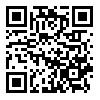Volume 14, Issue 1 ( Fall & winter 2018)
ijpd 2018, 14(1): 67-76 |
Back to browse issues page
Download citation:
BibTeX | RIS | EndNote | Medlars | ProCite | Reference Manager | RefWorks
Send citation to:



BibTeX | RIS | EndNote | Medlars | ProCite | Reference Manager | RefWorks
Send citation to:
Erfanparast L, Sohrabi A, Alizadeh M, Daryani A. بررسی میزان آگاهی و نگرش اعضای هیئت علمی دانشکده دندانپزشکی تبریز نسبت به آموزش ازطریق وب در سال 1395. ijpd 2018; 14 (1) :67-76
URL: http://jiapd.ir/article-1-206-en.html
URL: http://jiapd.ir/article-1-206-en.html
Associate Professor, Department of Pediatric Dentistry, Tabriz University of Medical Sciences, Tabriz, Iran
Abstract: (1701 Views)
Background: There is little information on web based teaching tools in dentistry education and the effectiveness of these new methods and technologies in teaching and research, is being discussed. This study was thus designed to determine the knowledge and attitudes of faculty members of Tabriz Dental School towards e-learning.
Materials and methods: This is a descriptive cross-sectional study and the study tool was a questionnaire. The validity of this questionnaire was examined by specialists in this field. The Cronbach's alpha coefficient was used to assess the reliability of the questions. In this descriptive cross-sectional study, all faculty members of the Dentistry Faculty at Tabriz University of Medical Sciences were asked to complete a questionnaire. The data were analyzed using SPSS 21 and a p value of less than 0.05 was considered significant.
Results: The knowledge of faculty members in Tabriz Dental School about e-learning was as follows: 38.86% was high, 48.13% moderate and 13.01% low. The attitude of faculty members in Tabriz Dental School about e-learning was as follows: 18.7% completely agreed, 44.0% agreed, 16.6% had no idea, 15.8% disagreed, and 1.4% completely disagreed. there was no significant difference between groups by gender, educational group and academic level. (p> 0.05).
Conclusion: In general, the knowledge of faculty members of Tabriz Dental School toward wed- based teaching was low. However, their attitude toward that was positive.
Materials and methods: This is a descriptive cross-sectional study and the study tool was a questionnaire. The validity of this questionnaire was examined by specialists in this field. The Cronbach's alpha coefficient was used to assess the reliability of the questions. In this descriptive cross-sectional study, all faculty members of the Dentistry Faculty at Tabriz University of Medical Sciences were asked to complete a questionnaire. The data were analyzed using SPSS 21 and a p value of less than 0.05 was considered significant.
Results: The knowledge of faculty members in Tabriz Dental School about e-learning was as follows: 38.86% was high, 48.13% moderate and 13.01% low. The attitude of faculty members in Tabriz Dental School about e-learning was as follows: 18.7% completely agreed, 44.0% agreed, 16.6% had no idea, 15.8% disagreed, and 1.4% completely disagreed. there was no significant difference between groups by gender, educational group and academic level. (p> 0.05).
Conclusion: In general, the knowledge of faculty members of Tabriz Dental School toward wed- based teaching was low. However, their attitude toward that was positive.
Type of Article: Research Article |
Subject:
General
Received: 2019/03/2 | Accepted: 2019/03/2 | Published: 2019/03/2
Received: 2019/03/2 | Accepted: 2019/03/2 | Published: 2019/03/2
References
1. Walmsley A, White D, Eynon R, Somerfield L. The use of the Internet within a dental school. European journal of dental education. 2003;7(1):27-33. [DOI:10.1034/j.1600-0579.2003.00268.x] [PMID]
2. Maleki Z, Goudarzi M, Mohtashami L, Faghihi B. Knowledge and attitudes of Dental Students and Academic Staffs towards Internet Usage in Dental Training in Shahid Beheshti University of Medical Sciences. . J Dent Sch. 2010;28(1):40-7.
3. Cobban SJ, Seale LN. A collaborative approach for improving information literacy skills of dental hygiene students. International journal of dental hygiene. 2003;1(1):49-56. [DOI:10.1034/j.1601-5037.2003.00005.x] [PMID]
4. Virtanen JI, Nieminen P. Information and communication technology among undergraduate dental students in Finland. European journal of dental education. 2002;6(4):147-52. [DOI:10.1034/j.1600-0579.2002.00251.x]
5. Rashidtorabi M, Ahanchian M, SaeediRezvani M. The attitude of department heads, faculty members, and physicians of Mashhad University of Medical Sciences toward continuing medical education through internet: Investigating some related factors. Iranian Journal of Medical Education. 2008;7(2):279-87.
6. Zolfaghari M, Sarmadi M, Negarandeh R, Zandi B, F A. Attitude Research under the Faculty of Nursing and Midwifery. Tehran University of Medical Sciences School of Nursing and Midwifery. Tehran University of Medical Sciences 2009;15(1):31-9.
7. Harirchian SM, Yarmohammadian MH, Bahrami S, Bahadorani M, Soleimanian M. Web-based Education; Study of Knowledge, Attitude and Practice of Faculty Members Isfahan University of Medical Science. Health Information Management. 2010;7(3):243-50.
8. Ebadi S, Abdi S, Ebadi M. The Impact of Information Technology to Transform Traditional Methods of Learning to Student-Centered Learning Methods. Islamic Azad University, Karaj - educational and cultural center Sama. 2010;20(3):22.
9. Twomey A. Web-based teaching in nursing: lessons from the literature. Nurse Education Today. 2004;24(6):452-8. [DOI:10.1016/j.nedt.2004.04.010] [PMID]
10. Moniee R. Developing of distance education in higher education: challenge & opportunism. Journal of Rahyaft. 2004;31(1):43.
11. Shuster GF, Learn CD, Duncan R. A strategy for involving on-campus and distance students in a nursing research course. The Journal of Continuing Education in Nursing. 2003;34(3):108-15. [DOI:10.3928/0022-0124-20030501-06] [PMID]
12. Thurmond VA. Defining interaction and strategies to enhance interactions in Web-based courses. Nurse Educator. 2003;28(5):237-41. [DOI:10.1097/00006223-200309000-00013] [PMID]
13. Bahadorani M, Yamani N. Assessment of knowledge, attitude and computer skills of the faculty members of Isfahan University of Medical Sciences in regard to the application of computer and information technology. Iranian journal of medical education. 2002;2(1):11-8.
14. Myers CB, Bennett D, Brown G, Henderson T. Emerging Online Learning Environments and Student Learning: An Analysis of Faculty Perceptions. Educational technology & society. 2004;7(1):78-86.
| Rights and permissions | |
 |
This work is licensed under a Creative Commons Attribution-NonCommercial 4.0 International License. |





